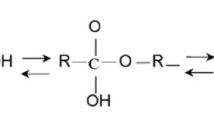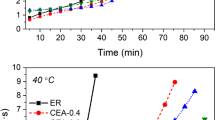Conclusions
-
1.
Our investigations have revealed the feasibility of using epoxy resins as a cementing material for plastic-concrete, glues, and paints at subzero temperatures; this is of interest for hydraulic engineering structures and the like, constructed in Siberia and the Far North.
-
2.
The structural strength of compounds hardening at −20°C decreases by a factor of 5–10 and the adhesion strength by a factor of 3, with a tendency to display a subsequent increase.
-
3.
The use of solvents greatly reduces the strength, the adhesion strength is less markedly reduced. At −20°C solvents preserve the composition but the cohesive strength is zero, whereas the adhesive strength has a specific value; after 60 days the decrease is not more than double the value observed in the absence of a solvent.
-
4.
A marked increase in the strength of the materialis observed in going from a negative to a positive temperatures; this is of particular importance for the use of epoxy compositions in construction work, including hydraulic engineering structures.
-
5.
The use of triethanolamine and DÉG-1 resin has a very beneficial effect on the increase in compression strength, but a similar effect is not observed in tensile tests.
-
6.
The indices of the degree of polymerization did not display characteristic features accompanying the structural strength of the compounds.
Similar content being viewed by others
Literature Cited
Annotation of Hydraulic Engineering Research Completed in 1965. VNIIG [in Russian], Énergiya (1965).
Brojer and P. Penczek, Utwazdzanie zywie epoksi jdowych w temperach nizcyzch od pokojowey,” Polimery-Tworzywa Wielkoczasteczowa,10 (1965).
É. M. Gvirts, L. V. Skrylova, et al., ÉD-5, ÉD-6, ÉDP, and ÉDL Dian Epoxy Resins [in Russian], Znanie (1965).
E. M. Blyakhman, L. V. Skrylova et al., Epoxy Resins Based on Polyhydric Alcohols and their Use [in Russian], Znanie (1965).
D. A. Kardashov, Synthetic Glues [in Russian], Mir (1967).
I. P. Losev and E. B. Trostyanskaya, Chemistry of Synthetic Resins [in Russian], Khimiya (1966).
B. N. Orlov, Properties and Methods of Acceletating Hardening of Epoxy Compounds at Subzero Temperatures. Symposium of Research by the All-Union Scientific-Research Hydraulic Engineering Institute (VNIIG) [in Russian], Énergiya (1968).
V. A. Kargin and G. L. Slonimskii, Brief Outlines of Physical Chemistry [in Russian], Khimiya (1967).
Additional information
Translated from Gidrotekhnicheskoe Stroitel'svo No. 3, pp. 19–22, March, 1971.
Rights and permissions
About this article
Cite this article
Pshenitsyn, P.A., Taldenkova, E.N. How subzero temperatures affect the hardening kinetics of epoxy compounds used in hydraulic engineering construction. Hydrotechnical Construction 5, 233–237 (1971). https://doi.org/10.1007/BF02378019
Issue Date:
DOI: https://doi.org/10.1007/BF02378019




